NIKE A.I.R. – THE AI DRIVEN PROTOTYPES
Imagine/ a shoe that matches the diverse personalities of different people. What is you passion, what music are you into, do you like books or computer games, are you a petrolhead or a yoga person, what would your individually designed shoe look like? Even though going that far may not be widely feasible any time soon, except for some minor customizations, like the color way for example, a leading shoe manufacturer, Nike explored this idea with their Nike A.I.R. project. Athlete Imagined Revolution (in short A.I.R.), is a line of 13 sneaker concepts featuring the use of Additive Manufacturing, in other words 3D print. Making this happen involved Nike’s design teams working closely with athletes and using cutting-edge technology like algorithms, artificial intelligence, and already mentioned 3D printing techiques. With these tools, Nike crafted prototypes for each athlete’s personalized shoe.




source: web
Using a combination of AI (Artificial Intelligence) and AM (Additive Manufacturing) is another innovative approach that brands are exploring to leverage current trends and stay ahead of the curve. This strategy ensures they don’t miss out on the latest developments in the industry. Nike is not the first brand to use the above mentioned technology, in fact, they seem to be very late. Brooks has been 3D scanning and 3D printing since 2017* (sic!), Adidas, Puma, Reebok, Under Armour, Asics or Decathlon, to name few, these brands have long been using 3D printing as a way to manufacture certain parts of their footwear. Luckily, Nike has just decided to join the pack.

source: web
The interesting part here, is also the use of AI in the design process. The first step was gathering data. Nike talked in-depth with its sponsored-athletes, among these were Kylian Mbappé, Vinicius Jr., Sha’Carri Richardson, or Victor Wembanyama to name a few. The point was simply to understand what they wanted in their ideal shoe. Athletes shared their thoughts on design, customization, and even personal details like their playing or running style or important life events. All the responses were put then into the AI through prompts, and the software returned hundreds of visual representations for each athlete. Next Nike’s designers used these AI-generated images to spark ideas for their initial designs, which they then showed to the athletes again for feedback. And that’s where good old manual labour of countless iterations began. The final concepts made their ways to the 3D-printer and so A.I.R. sneakers co-designed by each of the 13 athletes were born, from futuristic alien motifs to traditional beadwork, each pair embodied a blend of performance and personality.
A.I.R. isn’t just a typical design project; it signifies a fundamental change in how athletic footwear is imagined and developed. “For these prototypes to be successful, they must stir emotions,” John Hoke, Nike’s Chief Innovation Officer, said. “They must evoke a sense of awe for what lies just beyond the horizon, an optimism for the future. What I really hope this project stirs up is a sense of unlimited potential. Nike Air is a nearly 50-year-young technology. We’re only at the cusp of harnessing Air’s potential, its full expression. And these footwear prototypes show we’re nowhere near done.”

source: web
Please refer to Sole Retriever to read more about the individual designs and sources of inspiration.